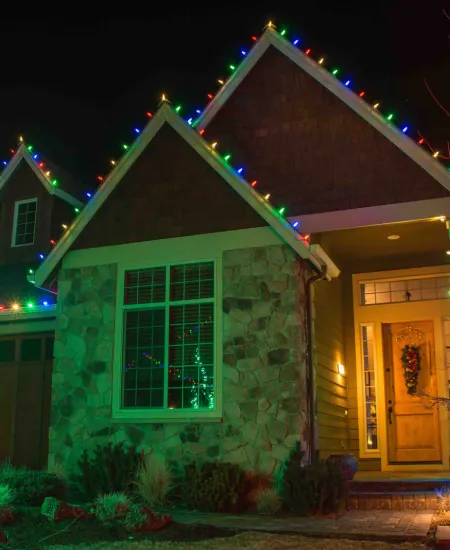Conquering the Elements: A Guide to Weatherproofing Your Holiday Light Display
Every winter, the world seems to transform into a glittering wonderland of lights. From the elaborate displays in malls to the quaint bulbs lining neighborhood streets, there’s just something magical about those twinkling decorations. If you’ve ever put up a holiday light display, you know that the behind-the-scenes isn’t quite as enchanting, especially when you’re contending with sleet, ice, and every conceivable form of winter weather. I’ve been there—unraveling cords in the cold, gloves off, feeling like my fingers might fall off! Let me share some insights and tips on making your light display not just beautiful but also durable against the whims of winter.
Understand Your Lights: Know What You're Working With
Before you even think about untangling that ball of lights from last year, it’s critical to understand what type of lights you have. Not all holiday lights are created equal. Some are made to withstand wet, winter conditions, while others are better suited for your cozy indoors.
- LED vs. Incandescent: LED lights are more durable, energy-efficient, and longer-lasting than traditional incandescent bulbs. They also don’t produce much heat, making them less likely to overheat or cause damage during a winter storm.
- Indoor vs. Outdoor: Check the packaging and labels on your lights. Lights designated for outdoor use are generally more rugged and have better insulation around wires to withstand wet conditions. If you’re unsure, here’s a great primer on testing your lights before installation.
One Christmas, I made the rookie mistake of using indoor lights outside—I was dazzled by their charm but not by the short circuit that followed. Lesson learned, always check the label!
Making Connections Secure and Dry
Electricity and water are not a merry combination. To safeguard your holiday lighting, pay special attention to where and how you connect your lights.
- Keep Plugs Off the Ground: Elevate connectors and plugs using a brick or a plastic container turned upside down. This simple step can prevent water from pooling around your connections, which is a common cause of short circuits.
- Use Outdoor-Rated Extension Cords: These cords are designed to withstand environmental elements and have a thicker coating. They are a must if your power source isn’t right next to your display.
- Waterproofing Connections: You can find waterproof electrical tape or even special kits designed to seal outdoor light connections. Wrapping your (reddit.com)
I remember one year when a sudden snowstorm hit, and the next thing I knew, half of my display went dark. A little knowledge about light section outages and waterproofing could have saved me a freezing, late-night repair session.
Choose the Right Location
Placing your lights in areas less exposed to direct weather impacts can prolong their lifespan and reduce maintenance hassles. Consider these tips:
- Avoid Low-Lying Areas: These spots can accumulate snow and water, potentially submerging your electrical components.
- Use Structures: Taking advantage of your home’s overhangs, or even setting lights in areas shielded by trees (only if it’s safe from wind), can provide some extra protection.
- Wind-Resistant Settings: Secure your lights tightly and evenly. Loose bulbs and strands can be damaged more easily by the wind, causing them to flicker or fail altogether.
There was a house in my neighborhood that beautifully integrated their lights along the edges of the roof and around solid frames around windows. This not only added to the aesthetics but also kept the setup sheltered from the harshest of weathers.
The Importance of Routine Checks and Maintenance
Weather can be unpredictable, and regular checks can be the difference between a spectacular light display and a dim one. Here’s what to keep in mind:
- Daily Check-Ups: A quick walk around your display each day can help you spot and resolve issues like loose bulbs or exposed wires before they become problematic.
- Post-Storm Inspections: After any significant weather event, give your display a thorough check to ensure everything is still securely attached and functioning properly.
I once discovered a whole section of lights that weren’t turning on, and upon inspection, I found a loose connector. Had I not caught that, it might have led to more extensive damage or even a safety hazard! For larger setups, consider centralizing control so you can monitor and manage everything more easily.
A Warm Conclusion
Setting up a weatherproof light display is all about the preparation you put into it before the holiday season fully kicks off. From choosing the right lights to setting them up thoughtfully, every little precaution plays a part in ensuring your holiday cheer isn't dulled by weather woes. Take it from someone who’s spent chilly evenings troubleshooting soggy bulbs: a little foresight goes a long way! (weather.com)
Consider each sparkling light as a poignant reminder of the warmth and joy of the season, shining brightly against the long winter nights. And remember, while the glow is temporary, the memories of a well-lit, festive home can last forever. So gear up, get practical, and let your holiday spirits (and lights) not be dimmed by mere weather.
Subscribe to our email newsletter and unlock access to members-only content and exclusive updates.

Comments